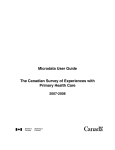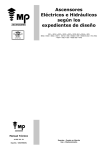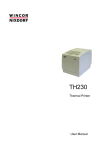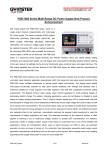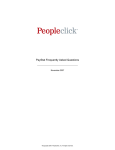Download Sampling Weights – User Guide Version 1
Transcript
Sampling Weights – User Guide Version 1 Background The CLSA is recruiting 50,000 eligible Canadian residents aged 45-85 years at baseline to be followed for at least 20 years (or until death or dropout). There are two components to the sample: (1) CLSA Tracking, whose target was 20,000 people from all across Canada; and (2) CLSA Comprehensive, aiming to recruit 30,000 people living within 25-50 km of one of 11 Data Collection Sites (DCS). The CCHS Healthy Aging sample is nationally representative. The eligible Canadian residents aged 45-85 years meet several inclusion criteria: Canadian citizen, landed immigrant or permanent resident; not living on an aboriginal reserve; not a member of the Armed Forces; not living in a long-term care home; able to conduct interview in English or French (not restricted by language or cognitive function). Sources for the Sample The sample for the Canadian Longitudinal Study on Aging (CLSA) was obtained via three sources: Canadian Community Health Survey-Healthy Aging (CCHS), Provincial Health Registry mail-outs (HR) and telephone sampling (TS) frames. Each of these used random sampling, in an effort to make the sample as representative as possible of the target population, i.e., eligible people in the general Canadian population. It is standard practice in surveys to use sampling weights. The sampling weights provided with the data aim to provide researchers with an estimate of how many people in each province (and in Canada) are represented by each CLSA participant. The aim is to ensure that, when estimating the mean value of some variable or the proportion with some characteristic, the value obtained is representative of the eligible provincial (and Canadian) population. The weighting is necessary because the probability of selecting individuals from certain sub-groups of the population varied. As well, the probability that those selected agreed to participate varied within groups. For example, the CLSA ultimately included a much higher proportion of people in PEI than of people in Ontario. If the sample weights are not used, any estimate of Canadian population means or proportions will be skewed toward the mean proportion for PEI. Using the weights in the calculations will remove this skewness. These weights are known as inflation weights. Note that we have computed trimmed values of the inflation weights. These allow for the fact that some weights were very large. At the time of writing, recruitment for the Comprehensive participants is ongoing; the weights provided are for the Tracking participants only. Additional weights will be incorporated into the data as and when necessary. Last updated: March 27, 2015 V 1.0 Page 1 of 2 Which Sampling Weights should I use? For estimating means and proportions for the population, the trimmed inflation weights should be used. For analyses that examine relationships between variables at the national or provincial level, analytic (rescaled) weights are provided and should be used. For analyses of smaller sub-groups, the rescaled weights are likely to be appropriate. However, some consultation with a statistician is recommended. Using the Sampling Weights For this release of the data from participants interviewed by telephone, we provide two weights for each participant: the trimmed inflation weight and the analytic weight. In the future, researchers using the data will need to take account of exactly which data they are using when determining which sample weight to use. For example, researchers might wish to use data from all 50,000 participants (combining the 20,000 participants who have a telephone interview only and the 30,000 who have a home interview and assessment at a Data Collection Site). The appropriate weight would also depend on whether the analysis uses longitudinal data, combining data from different waves of the study. Additional weights and advice on their use will be provided when more data are released. Note that the actual number of participants interviewed by telephone is more than the target of 20,000; it is 21,241. For more details about the sampling weights, please refer to the Technical Document. Last updated: March 27, 2015 V 1.0 Page 2 of 2


